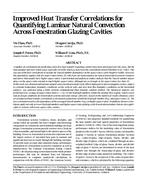Click here to purchase
The Earth is already suffering some of the effects of climate change, such as rising temperature, more frequent storms, and increased precipitation, etc. Canada seeks to reduce the greenhouse gases emission by a consistent improvement in energy efficiency of buildings from current building code to net-zero energy ready buildings by 2030. These measures will significantly reduce the energy consumption of buildings. However, with the changing climate how these buildings designed based on historical weather data would perform under future climates. This paper attempts to answer this question by investigating the effect of climate change on the energy demand and overheating risk in a single-family detached house with different energy efficiency levels, i.e. NECB that meets current National Energy Code of Canada for Buildings (NECB), and passive house (PH) that meets the PH requirements. Two climate zones in Canada are simulated, i.e. zone 4 (Vancouver); and zone 6 (Montreal). RCP 4.5 and RCP 8.5 emission scenarios are used to generate future climate for 2030, 2060 and 2090 horizon year. The simulation results showed that for both NECB and PH cases and under different climate zones, heating energy demand would be reduced by 5-48% by 2090, while the cooling energy demand as a percentage of the total energy demand would be increased from 0% under historical weather up to 60% by 2090. The climate change affects the PH case more than the NECB case and under zone 6 more than zone 4. The overheating hours would be increased by 27-43% for the NECB case, 44-50% for the PH case, respectively, under predicted 2090 weather conditions without natural ventilation. With the implementation of mitigation strategies such as natural ventilation, the overheating hours under future climate would be reduced to 7% of the summer time for Vancouver and to 21% of the summer time for Montreal. In conclusion, buildings designed based on historical weather data would perform differently under the changing future climates, thus the efforts should be made to design buildings that would be adaptable to climate change.
Citation: Thermal Buildings XIV 2019
Product Details
- Published:
- 2019
- Number of Pages:
- 8
- Units of Measure:
- Dual
- File Size:
- 1 file , 2.2 MB
- Product Code(s):
- D-Bldgs19-003


